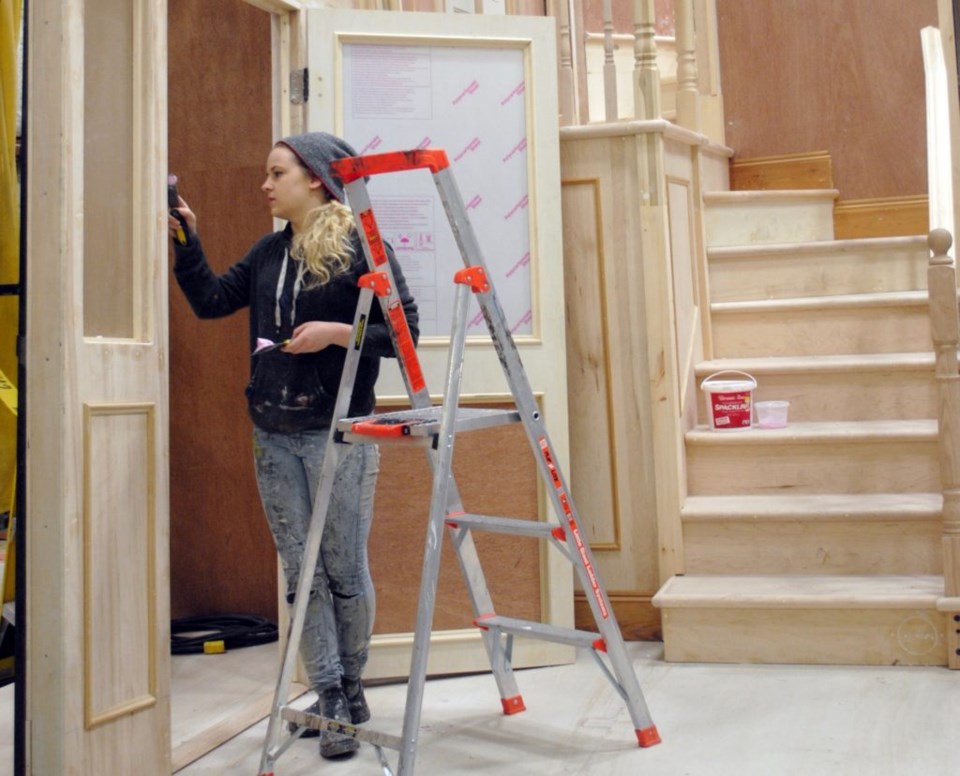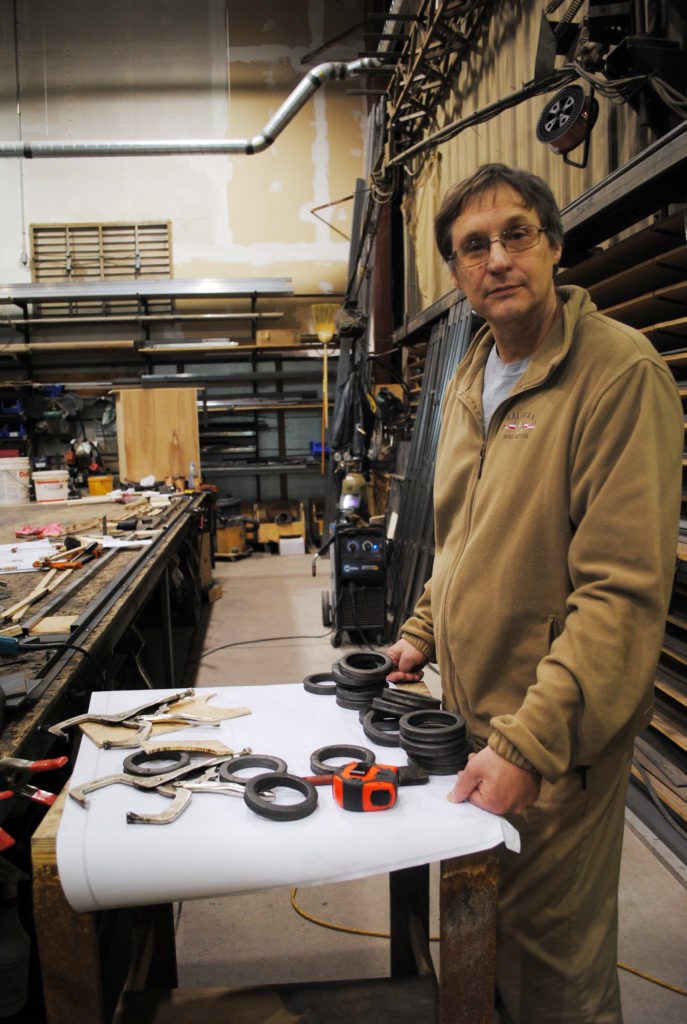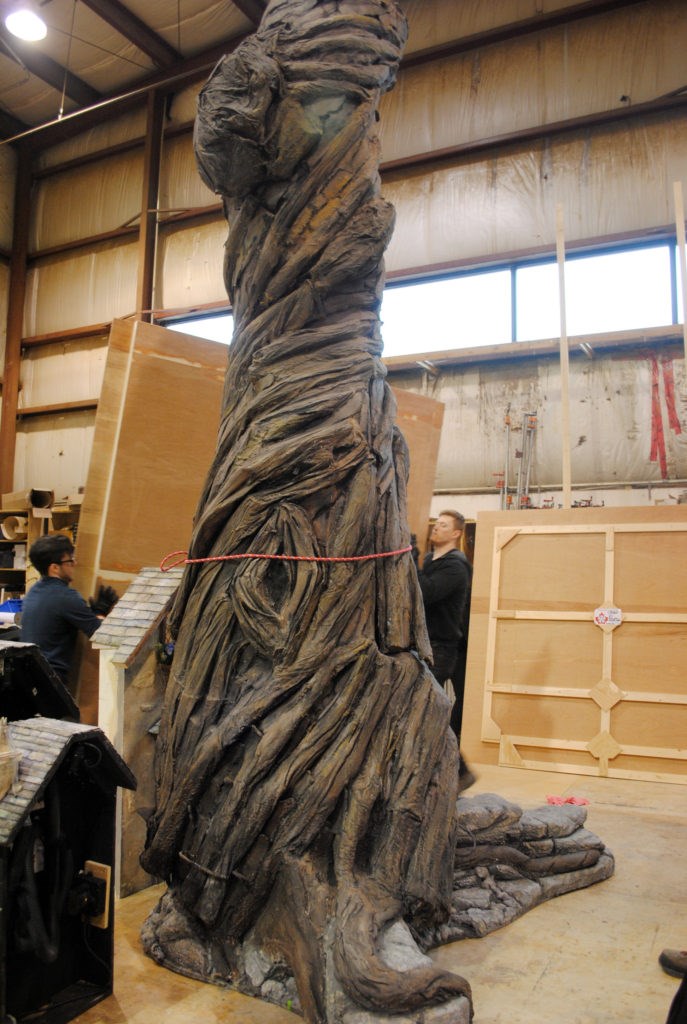
There is magic in Virgil. Theatre magic.
The Shaw Festival’s scenic construction and art shop are tucked away in a warehouse near the local car wash, in a bland white building that belies the miracles happening within.
Theatre is a series of deceptions, delightful sleights-of-hand. On stage you’re led to believe a local dedicated father of two is an outspoken gay man; a hilarious, radiant redhead is a meek and mousy chambermaid. The sets the actors perform within are part of the ruse: This wire bundle is a tree; that curtain is a forest. The latter is all conjured up in Virgil.
Lesslie Tunmer is the head of scenic construction, the person through whose brain and hands every piece of scenery on a Shaw stage will pass.
He’s overseeing the return of the sets of Brigadoon, sent back from the stage for modifications improvised during rehearsals. Actors will now be dancing on rooftops, so they need steel reinforcements. To maintain the flow in a scene, a door must open from the other side. “During rehearsal it’s trial and error,” says Tunmer. “I have rehung 11 doors so far this season.”
Eight truckloads of sets will be travelling up and down Niagara Stone Road on this day, between the construction shop and the Festival Theatre.
At the same time, sets are being built for Cyrano de Bergerac and The Ladykillers. “It’s going to be chaotic,” says Tunmer, with no shortage of glee.
The Johannesburg-born engineer has been with the Shaw for 30 years, working with designers, directors, and even fight directors to get the sets just right. “Listening is the most important thing. I have to listen to the designer to get their intent, and then get as close to the look as I can,” says the genial genius.
Tunmer gets the look by using detailed calculations, making art into math and matter. Some designers, such as Judith Bowden who designed Ladykillers, create models to scale. “She starts with white card, a ‘white model,’ then progresses to a proper model which I turn into AutoCAD drawings,” explains Tunmer.
The main set piece for Ladykillers is in the “fit-up” or assembly space, where there are motors in the sky-high ceiling to, in this case, lift nine- and 10-foot girders into place to complete the look of the off-kilter building. “The set is supposed to be a fragmented piece that deconstructs as it goes up,” explains Tunmer.
In an unusual break from tradition, the cast of this play will be brought to the shop to test out the set in situ, before they get more deeply into rehearsals without getting the feel of it. “The tactility is incredibly important, especially with this set — most of the angles are not 90 degrees,” says Tunmer. He mimes actors turning corners quickly, finding their marks, squeezing into tight spaces. “They need to feel the dimensions.”
“This is only going to be done once and we’ll never do it again,” says Tunmer — describing the Ladykillers set, and every other piece he oversees. Each set is bespoke, not to be used twice. Unable to store the used pieces, they are typically thrown away, after being scavenged for pieces such as steel and hardware that can be recycled or used again. Occasionally people ask to acquire specific pieces, but the cost of shipping them is typically prohibitive.
Another trick of the trade is designing and building everything — even this full-on three-dimensional edifice for Ladykillers — to be easily broken into bits of a maximum 10-by-10 feet. They have to be able to fit through shipping doors, into and out of trucks, and also taken apart and reassembled by stage crews during changeovers. On any given day there might be preparation for three different shows on one stage, with often less than three hours to break apart one illusion and put together a whole new one before the audience finds their seats.
“It’s unbelievably stressful,” admits Tunmer, “but I still love the job, I’m still smiling.”
In the welding bay, pieces of metal are being molded and soldered for the sets of Cyrano de Bergerac. In other areas, air casters — one of theatre’s coolest secrets — are being attached to “trucks,” moving set pieces. The casters are pneumatic, a wheel under an air cylinder, and operated by the simple touch of a button. “When you add air the structure lifts; when you take it out, the structure drops,” explains Tunmer. “If you run out of air you’re screwed,” he says, laughing.
The rock and roll and masculinity of the construction side are sharply contrasted by the classical music and genteel air of the scenic art shop, where Gwyneth Stark runs the show. “We’ve been really, really, really busy,” she says of the season which, for her, began last fall. “I start whenever they start screaming,” she says with a laugh. “Last year that was in September.”
Since then she and her team have trompe l’oeil painted 10 houses and a tree as tall as a house, stone archways, a flagstone patio and more, for Brigadoon and Getting Married. They’ve dotted hundreds of yards of canvas with whimsically patterned and coloured backdrops for The Horse and His Boy — using foam rollers carved with woodturning tools to create the desired pattern.
Currently they’re transposing a designer’s drawing of a forest onto an enormous piece of canvas. ”This backdrop is 60 feet by 30 feet, the size of the proscenium,” Stark explains. “We are transcribing a drawing on a half-inch to two-foot scale.” They use tools such as a piece of rope to help draw outlines, and a marking tool on an extension so they’re not crawling around on the floor. Much of their work, like that next door, involves finding the trick that creates the illusion.
Stark is fond of Textilene, originally designed to cover speakers at rock concerts, and also used as a solar screen. “If you light it from the front it looks solid,” explains Stark. “But if you light it from the back it’s transparent. We cut four stencils out of a plastic tablecloth from Penner’s to make the wallpaper in Rope,” she says, holding a panel covered in the PVC-coated polyester mesh.
“Every designer wants their own unique look,” says the Scottish artist who moved to NOTL in 1989. “it’s never the same thing twice."




